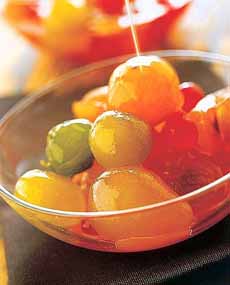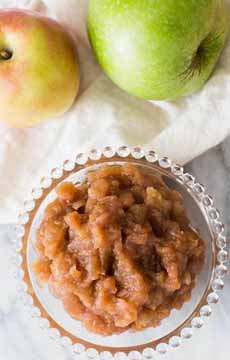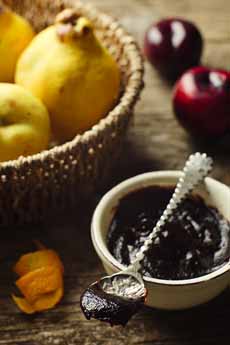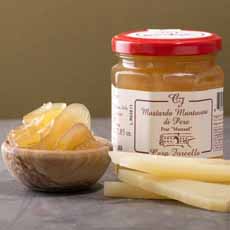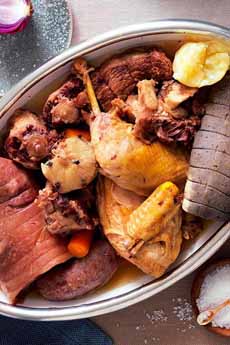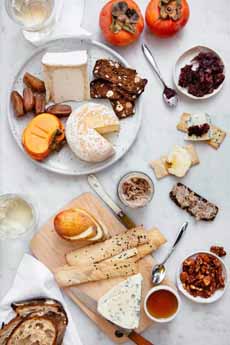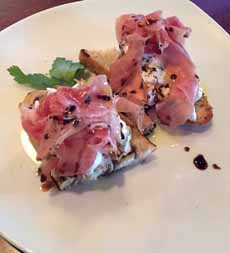TIP OF THE DAY: Mostarda, A Sweet-Hot Italian Condiment
 [1] The classic: mostarda di cremona. Here’s a recipe to make your own from The Spruce (photo © The Spruce).
|
Years ago, on a trip to Italy, we first came across mostarda di frutta, mostarda for short. A sweet-and-hot, fruit-and-mustard condiment from the north of Italy, it’s our go-to condiment with Italian cheeses, and some other nationalities on the cheese board. We offer more uses below. Think of mostarda as a mustardy fruit chutney—although mostarda uses mostly candied fruits. (The Italian word for mustard in the English language is senape). Candied whole small fruits or larger pieces of fruit are beautifully suspended in a clear syrup flavored with mustard oil. It’s clear and doesn’t cloud the syrup. Home recipes often use mustard powder mixed into white wine. Some mostarda are lovely to look at, like part of a still-life painting. It is cooked slowly (often over three days) to maintain the natural bright colors of the fruit and the perfect texture. It burns because of the addition of crushed mustard seeds. Once crushed, the seeds release the fiery mustard oil that gives the mustard condiment its flavor. From the Middle Ages forward, man has sought ways to enjoy the fruits that are scarce in winter, at least through the celebrations of Christmas. Mostarda is a food born from the need to preserve fruits for the off-season. Originally, the fruits were preserved in mosto (grape must*), unfermented grape juice that has been reduced to syrup. Mostarda’s origins date back to the honey and mustard condiments of ancient Rome. Grape must (freshly pressed grape juice) was mixed with ground mustard seeds and honey to create a sweet mustard. Later, fruit was added. Recipes for “modern” mostarda, dating from the 13th century, call for the use of grape must. The first written document “Fruit Mostarda for festive season” dates to 1393 and is attributed to Galeazzo Visconti, Duke of Milan [source]. From that point on, cookbooks began to include mostarda as a main ingredient. By the 19th century, there were some 93 different varieties. The sweet heat went really well with boiled meats. Initially, mostarda was served with bollito misto, a plate of mixed boiled meats that’s a specialty of northern Italian cuisine (there’s more below about uses for mostarda). According to legend, mostarda was invented by chance in medieval times. In an apothecary shop, a piece of melon fell unnoticed into a barrel filled with honey. When it was later discovered, the melon was still as delicious as if it had been freshly picked (honey, which is virtually moisture-free, is an excellent preservative) [source]. Mostarda itself takes on different ingredients in different regions, incorporating local fruits—whatever is plentiful in the region. Raisins, nuts, spices and other ingredients can be added. As one source notes, almost every town in the Po valley has its own recipe. There are many, many mostarda recipes, from grape and fig (uva e ficchi) to vegetable mustards (also candied) modern recipes with non-Italian ingredients, from cardamom pods to pineapple and pumpkin. Here are some of the most famous, named for the areas where they originated. |
|
|
|
||
|
WAYS TO USE MOSTARDA
Any discussion starts with bollito misto a fundamental part of Northern Italian cuisine. It’s a one-pot meal, Italian comfort food. The boiled meats vary by region, and a very elaborate presentation can include seven kinds of meat and fowl, seven vegetables and seven condiments. The meats can include beef brisket, beef cheeks, calf’s tongue, chicken or capon (or turkey), cotechino sausage, pork shank, sweet Italian sausage, veal shank—slowly boiled in a large pot with carrots, celery, onions and potatoes. The cooked cooked meats are sliced, placed on a platter and served with mostarda—or, for those seeking a different flavor profile, with a green herb sauce (salsa verde). The savory broth that remains in the pot can then be turned into soup. Why not plan a dinner party, with a multi-mostarda tasting? Over time, mostarda became a broad-purpose condiment. The heat of mostarda varies by producer. In general, however, it needs a hearty food that can show off both the sweet and the heat. Serve mostarda with: Don’t be put off by the high price for a small jar. If you look at the ingredients in the recipe, you’ll see it as a bargain. Serve it at your next get-together—two different types, if you can. Let us know how you like it. And let us know if you come up with new ways to use it. CHECK OUT WHAT’S HAPPENING ON OUR HOME PAGE, THENIBBLE.COM. |
|
|
|
|
||
